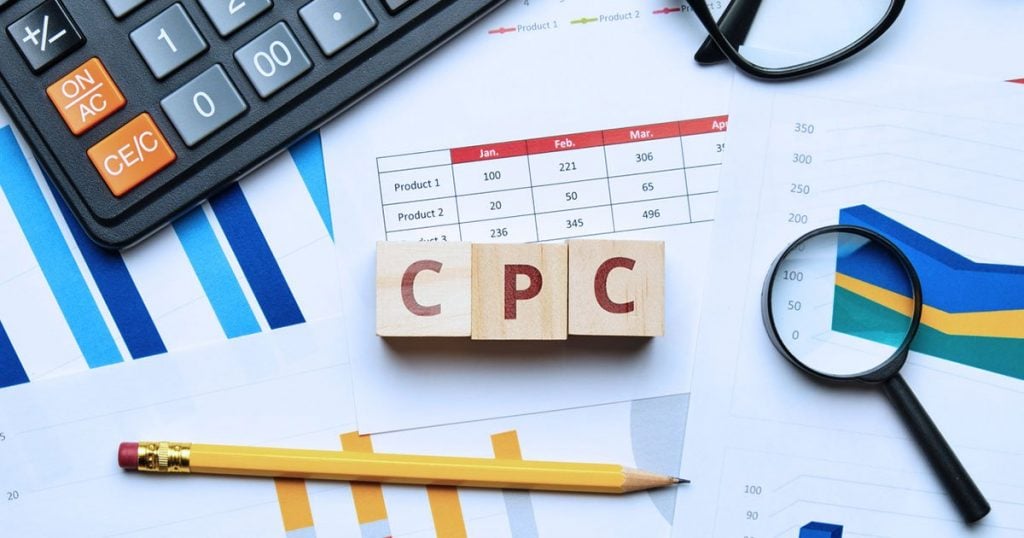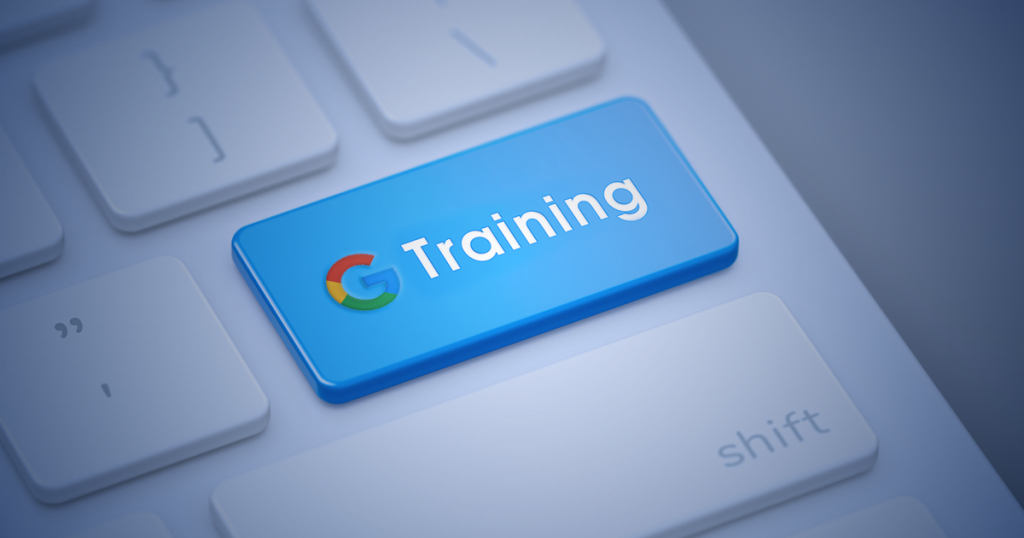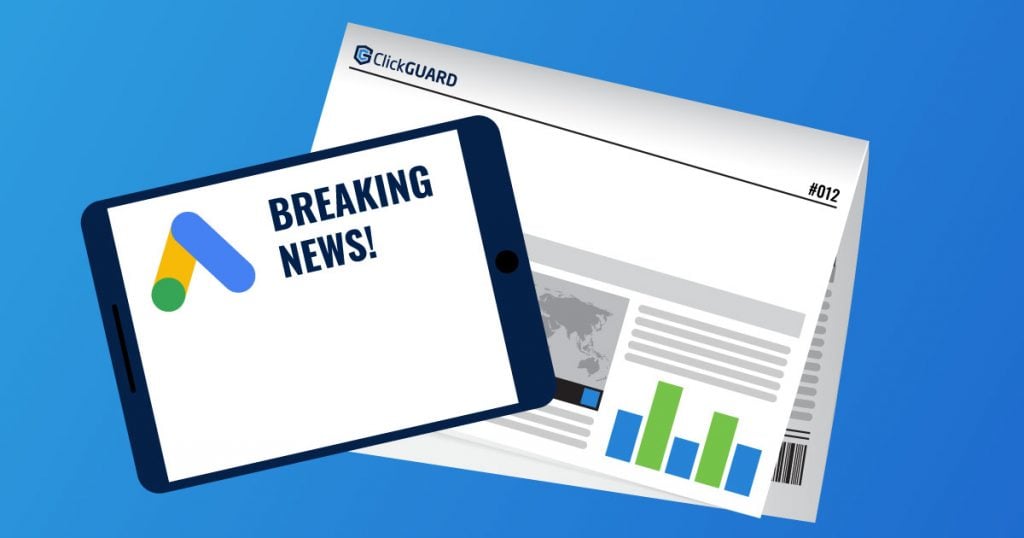If you ever run a Google ad campaign or any type of ads on any ad network, you are probably familiar with the term ‘CPC’. It is, after all, one of the core metrics that you have to measure, analyze, and interpret when running an ad campaign.
If you are new to CPC, and not sure what is CPC and how to calculate CPC, this guide is for you. This actionable CPC guide will cover everything you need to:
- Know about CPC
- What is CPC
- Why it is important
- How it relates to ROAS
- How to calculate CPC
- CPC benchmarks
- How CPC changes across industries
- Learn actionable tips and techniques to lower CPC
…and more (much more!)
Let’s get started…
What is CPC?
Cost per Click (CPC) is defined as the cost you pay for a single ad click. It is one of the most used online advertising models for Pay per Click (PPC) ads. When you set up an ad campaign in Google Ads (or any other ad network), you’ll be asked to select a model (or a bidding strategy). Selecting CPC will mean that you’ll be charged by the number of clicks your ads receive, irrespective of impressions.
When you set up a campaign this way, you set a maximum CPC that you can afford to pay per click, and then you are charged every time your ad is clicked. This is the total opposite of the Cost per Impression (CPM) model, where you are charged on the number of impressions your ad receives (as the name of the model not so subtly suggests it, right?)
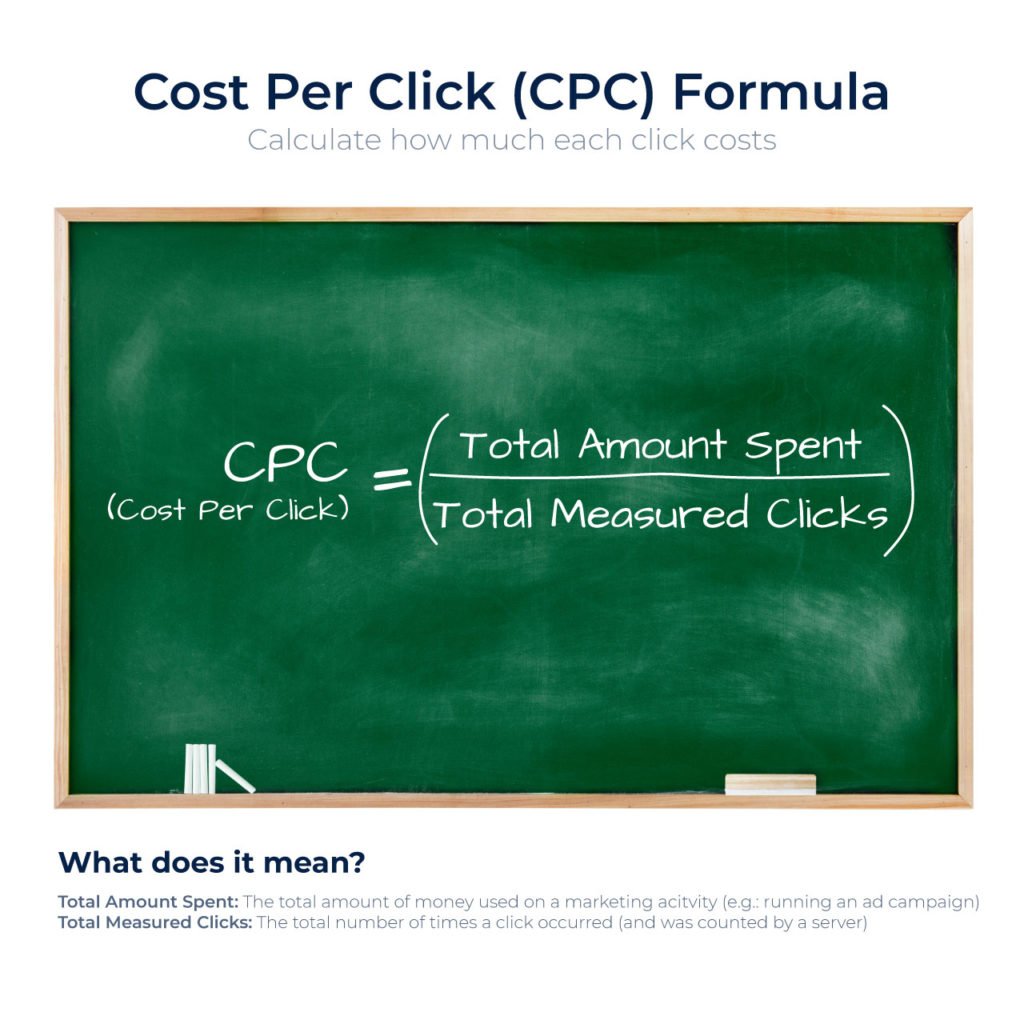
Let’s assume you are running an ad campaign with CPC bidding with a maximum CPC of $1. This means you are willing to spend a maximum of $1 per click and in this case, the average cost per click will be $1 or less. Keep in mind that, when determining the cost you are being charged for a click, you need to refer to the average CPC that shows the estimated cost per click for your campaign.
How to Calculate CPC
Now that you know what is CPC, let’s move forward towards calculating CPC. Here is how to calculate CPC:
You have to divide the total amount spent by total clicks received, this will give you CPC:
CPC = Total amount spent / Total clicks
Thankfully for all those of us who really didn’t like math in school, you don’t have to calculate CPC manually. Pfew! The ad network will show you the average CPC for each keyword and overall campaign or ad CPC. The fact that metric is automatically calculated for you also means that you can make better decisions. Cheers to data-based decisions, right?
Types of CPC
Knowing what is CPC and how to calculate CPC isn’t just enough – you have to have an understanding of the different types of CPC. When running an ad campaign, there are three different types of CPC you might have to deal with:
- Average CPC
Average CPC is the overall average cost per click that is calculated by measuring total clicks and total amount spent. The maximum CPC refers to the maximum cost per click that you can afford to pay. This is the amount that you select when creating your ad campaign.
- Maximum CPC
Maximum CPC is the maximum cost per click that you can afford to spend per click. Once you set a maximum CPC, you’ll never pay more than it for any click.
For example, if your maximum CPC is $3, you will be charged $3 or less per click depending on the bids and competition. Google will never charge you more than your maximum CPC.
- Actual CPC
This is the exact CPC you pay for the click and it is always equal to or less than the maximum CPC. Actual CPC is a tricky one that you must understand to optimize your ad campaigns. For example, here is the formula Google Ads used for the calculation of Actual CPC:

The Actual CPC is what you’ll be charged and it is determined by the ad rank of your competitor and your quality score. Needless to say, the higher your ad quality score is, the better it is for you, because it will lower your actual CPC.
Here is an example:
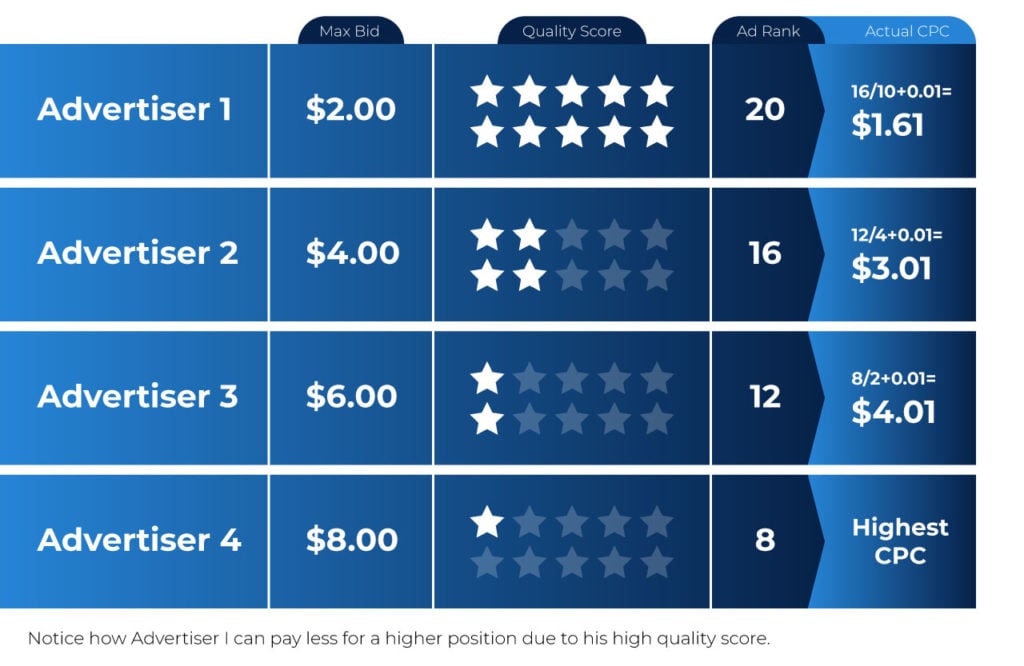
Here is where things get really tricky, though: The CPC you pay isn’t all in your hands because it depends on the ad rank of the bidder below you. And ad rank depends on 6 major factors:
- The ad rank threshold
- Your bid
- Your ad and landing page quality
- Auction competitiveness
- Searcher’s intent
- Ad extension and ad format impact.
This means that, if your competitors score better on these metrics, they’ll have a better ad rank that will increase your actual CPC. And of course, it works the other way too.
The good news in all this is that you can improve your ad rank to outperform other bidders and you’ll then have the lowest CPC for any given keyword.
Is CPC Unique to Google Ads?
Short answer?
No, it is not unique to Google Ads.
Let’s refer back to what is CPC. Well, it is the cost per click that you pay to the ad network and it is a standard metric that isn’t unique to Google Ads or any other specific ad network. It is used by all the ad networks ranging from Facebook ads to Bing ads to Twitter and more. CPC is not just for the ad networks. In fact, CPC is a standard digital marketing metric that is used to measure cost per click for advertising campaigns across all networks.
Cost per Click is variable and changes based on several factors (refer to how to calculate CPC in the previous section). You don’t pay an exact Cost per Click for the same keyword because there’s always fluctuation in competition, ad relevance, keyword relevance, and other factors.
Why Track CPC?
Why exactly do you need to measure CPC? What makes it special?
There are several good reasons for tracking CPC when running an ad campaign with Google Ads:
1. It improves PPC Campaign Efficiency
Having a clear understanding of what is CPC and how to calculate it helps improve your campaign’s efficiency, precisely because it will enable you to see keywords and ads with high vs. low CPCs. This also allows you to pause ads and keywords that are eating your budget but aren’t converting.
Imagine looking at your ad report and you having no idea of what is CPC and what role it plays.Will you be able to optimize your PPC campaign in this scenario?
Not at all.
Same holds true for how to calculate CPC. If you don’t know the formula, the CPC column in the report will make no sense to you with all those percentages.
PPC optimization starts from CPC optimization and ends with dealing with fraudulent clicks and preventing invalid clicks from consuming your ad budget.
2. It Helps You Compare Keywords
If you are running a search PPC campaign, CPC helps you compare the cost of different keywords. You can identify keywords that are worth targeting based on their CPC, conversion rate, and importance.
Here is an example:
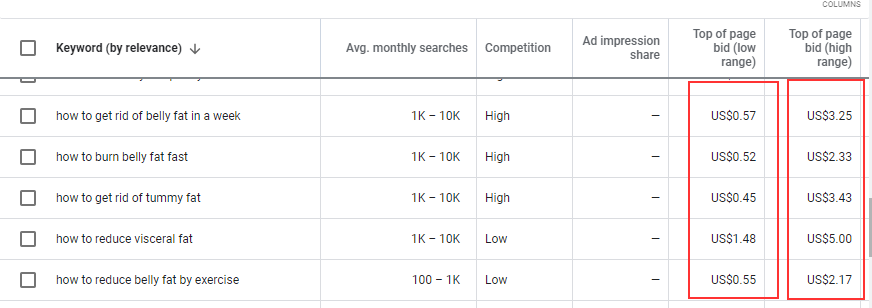
You can see how related keywords have different CPC ranges. Initially, you can target multiple related keywords, and once your campaign starts receiving clicks, you’ll be in a better position to compare keyword costs and conversion rates.
This will give you a good idea of what keywords to pause and what keywords to continue spending money on.Woohoo! Long live data-based decisions! Again! ✨
3. It Helps with Cost Estimation
One of the best things about CPC is that it gives you a realistic picture of the cost before you create your PPC campaign. This helps your budgeting by a lot. I mean you don’t just know what is CPC, you know the estimated amount you will be spending on any given PPC campaign.
All the keyword research tools including the (in)famous Google Keyword Planner show you the historical CPC of your target keywords. You know the estimated Cost per Click you’ll be charged before adding a keyword to your PPC campaign. This gives you a rough idea of the cost of the campaign (which ultimately helps you in terms of decision-making, budgeting, and planning).
Industries with the Highest CPC
The average CPC varies significantly based on the industry and niche you are in. Some industries have high CPC while others have low. WordStream publishes Google Ads average CPC reports for major industries that help you compare your CPC with your competitors.
Again, having a sense of how to calculate CPC will help you better understand the report. Here is the Google Ads CPC for major industries 2020:
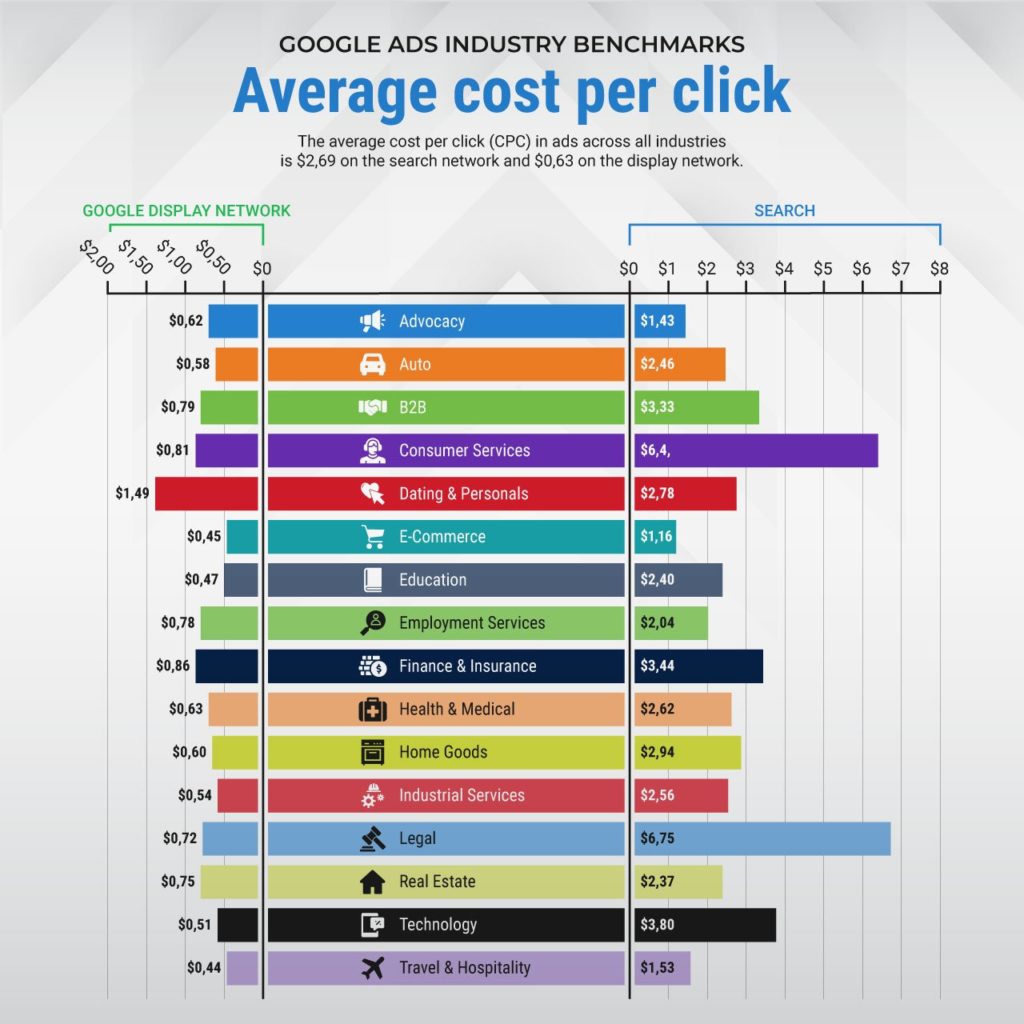
The Legal ($6.75) industry has the highest average CPC for search, followed by Consumer Services ($6.40). The Dating and Personals industry ($1.49) has the highest CPC for the Google Display network. As you can see, there is a lot of difference between search and display CPCs.
The average CPC for search is extremely high while the display network has CPCs under $1 across industries (except for the Dating and Personals industries). This gives you a good idea of what types of PPC campaigns you need to run based on your budget and what is CPC for your industry.
If you have a limited budget and don’t want to spend a lot of money on CPC, go for display ads. If you are interested in conversions, sales, and brand awareness, search PPC is the way to go.
The average CPC is just an estimate and it is variable. The actual CPC you’ll be charged might be too low or too high as compared to the benchmark report. Why?
Because it depends on several factors, including the number of advertisers bidding for a specific keyword in your industry. Let’s assume that a big competitor sets the maximum CPC for a relatively cheap keyword above $20 to outbid competitors or to exhaust the ad budget of smaller competitors. In this case, you’ll have to pay a very high CPC for a fairly cheap keyword to be on the first page.
Or, it might be that you are the only one bidding on a keyword and you might get the top ad position for a fairly expensive keyword at a low cost.
Cost per click is variable and there is no way you can identify it upfront. Industries having a lot of competition and big players (e.g. legal, finance, consumer services, etc.) have higher than normal CPCs.
How Does CPC Affect Your ROAS?
This is where you will get to know the real benefit of a clear understanding of what is CPC and how to calculate CPC. Well, CPC directly impacts your ad cost, which means CPC plays a direct role in your ROAS. By the way, here is the formula that is used for the calculation of ROAS:
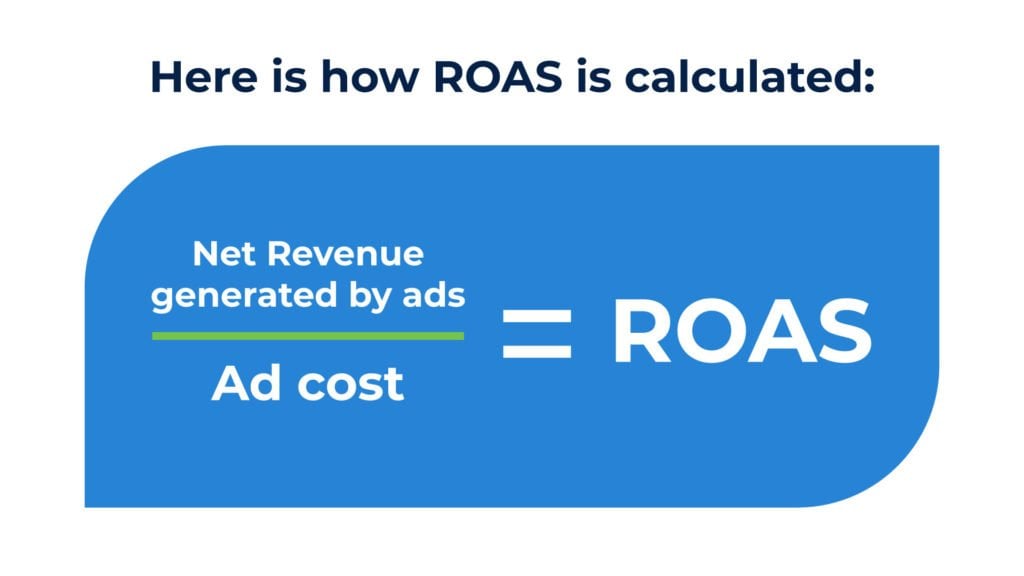
What this formula actually means is that high CPC leads to an increased ad cost which will reduce your ROAS. CPC is one of the many factors that account for ad cost, so its impact on the overall ad cost might be significantly low but (not inexistent)..
In general, an ad has a lot of costs such as copywriting, administrative, cost of tools, partner costs, and several others. If you are targeting keywords that have a significantly high CPC, your ad cost will increase which will impact the ROAS depending on the ad revenue.
This is one of the main reasons you should look for ways to reduce CPC ( to increase the ROAS).
Tips to Optimize Your CPC
Let’s go beyond what is CPC and see how you can improve it. Again, if you refer to how to calculate CPC, you will notice that increasing your ad budget will increase (and optimize) CPC right away. However, you can use other techniques and tactics to optimize your CPC ( and improve your ROAS as a result).
Here are the best tips and tricks to optimize your CPC:
1. Improve Quality Score
This is the most crucial variable that determines not only CPC but ad rank. According to Google, a high quality score reduces CPC and helps you achieve a better ad position. Quality score depends on the quality of:
- Your ads
- Keywords
- Landing pages
Therefore, the first thing you need to do is try to achieve the maximum quality score. It will lower your CPC and you’ll outbid and outrank your competitors. The best and the only way to achieve a 10 quality score is by making your ads relevant.
Let me repeat this. Your ads, keywords, and landing pages must be relevant.
The copy must be relevant to the keyword and searcher intent. When a searcher lands on your landing page, it must be relevant to both the ad copy and keyword.
This will improve CTR and conversions too, by the way.
2. Use Negative Keywords
Negative keywords restrict your ads from triggering. Using negative keywords intelligently has two main benefits:
- You optimize and lower CPC and overall ad cost by not bidding on irrelevant keywords that don’t convert.
- Negative keywords hurt your quality score as they aren’t relevant to the ad copy and landing page and usually have poor CTR and conversion rate. Adding such keywords to negative keywords improve quality score.
What you need to do is monitor your keywords and look for keywords with poor or no conversions. These are the keywords that you need to add to the negative list.
3. Use Ad Extensions
Ad extensions and ad format impact ad rank directly. Any ad extension that improves ad performance and is useful for the searcher will improve ad rank and lower your CPC.
For example, adding your phone number during working hours will help mobile users call you directly. This will improve your ad rank and will lower your actual CPC.
4. Bid on Long-Tail Keywords
Research shows that long-tail keywords generate 80% of organic traffic:
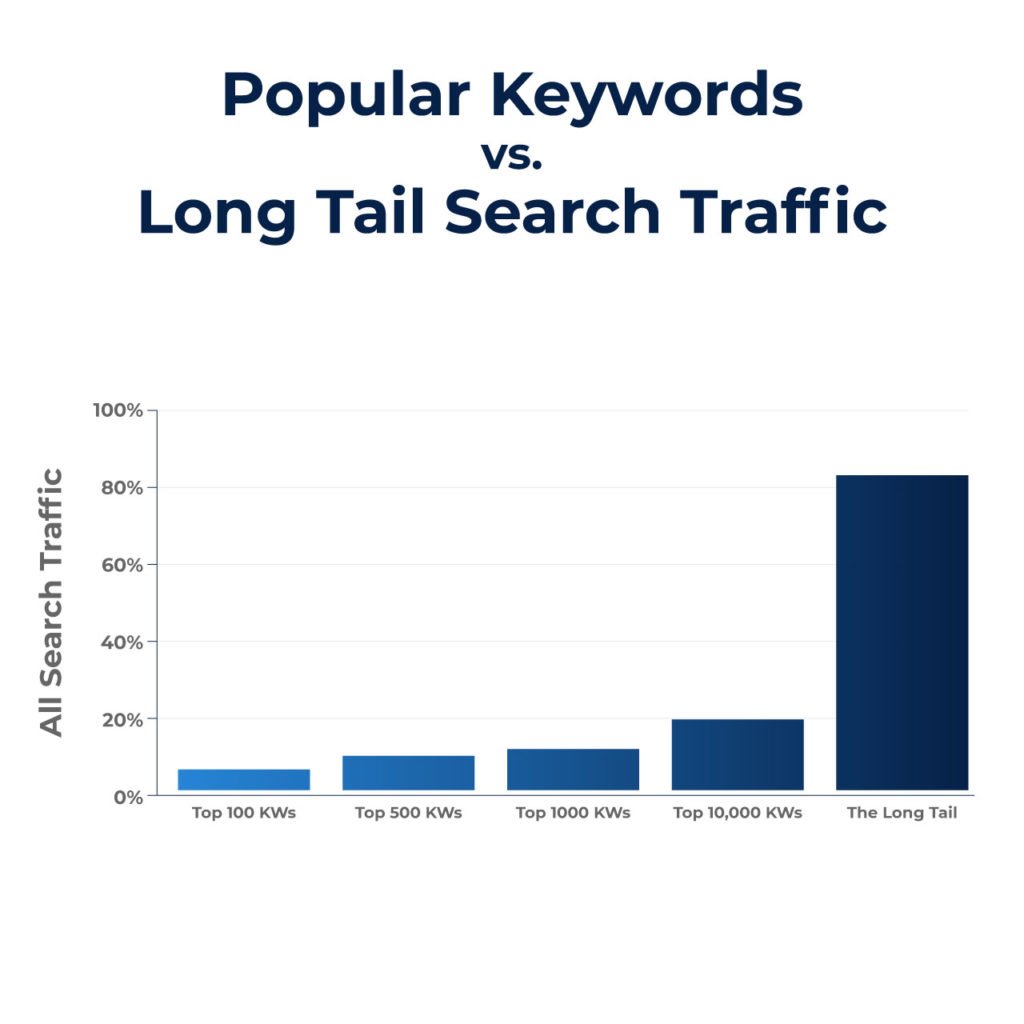
Targeting long-tail keywords (especially new ones) means you are in a no-competition zone. Most advertisers bid on high-traffic keywords as it drives clicks and conversions. This makes these keywords highly competitive and their CPC increases exponentially.
You don’t have to bid on such high competition keywords all the time.
Instead, bid on long-tail keywords. These keywords might not have a high search volume but bidding on 100 long-tail keywords having search volume between 50-100 per keyword means you can drive 5K to 10K visitors with such keywords.
The best part: You pay a very low CPC. Hooray!
Yes, you have to spend additional time on finding long-tail low-competition keywords but it is worth your time.
5. Monitor Time, Device, and Location
You can’t create an ad campaign on Google and let it run with an intention to achieve results. PPC isn’t a set and forget advertising method. You have to constantly monitor your campaign, ad groups, ads, and other variables, especially time, devices, and location.
Identify days, time of the day, devices, and locations with higher than average CPC and which have low conversion rate than the average conversion rate for the campaign. Exclude all such times, devices, and locations.
For example, let’s say your report shows that the CPC for a campaign you are running for your ecommerce store is significantly high during working hours due to high competition (as physical stores run ads during working hours).
In this case, you can pause your ads during working hours (as you have an eCommerce store only, right?) This will put you out of your competition’s way and help you pay a significantly lower cost per click (as compared to your competitors who run ads during working hours).
This calls for an in-depth analysis of your ad reports. Google Ads provides you with tons of data, it is you who have to use the reports for monitoring and decision-making.
Monitor CPC variation across devices, location, zip codes, days, timings, demographics, and other variables. Don’t let your ads run without any supervision, because as soon as you start monitoring ads, you’ll identify a lot of leakages.
Final Words
Cost per Click is the most basic PPC metric that drives your advertising campaign. It determines ad cost, ad rank, ROAS, and ROI. Ignoring cost per click when running an ad campaign might have dire consequences that will ruin your campaign and will have a negative impact on marketing and advertising budget and ROI.
Now that you know what is CPC and how to calculate CPC, you are in a much better position to optimize your PPC campaigns and reduce overall advertising cost.
And while you are trying to lower CPC, don’t ignore invalid clicks that might be eating your advertising budget. Using a powerful click fraud detection and prevention tool will ensure that you don’t pay for invalid clicks and spend your budget on valid clicks that actually matter. Just sayin’.
